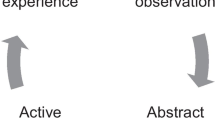Abstract
Background: As more patient care moves into the outpatient arena, teaching medical residents in this setting has become of critical importance. Ambulatory teaching is especially challenging due to highly variable, unpredictable learning needs and little time for teaching. Recent literature suggests many strategies for effective teaching; however, most are not grounded in education theory.
Summary: Using precepts of Adult Learning Theory, we review the literature on educational strategies for teaching medical residents in ambulatory settings. Many well known strategies apply the principle of learner involvement in setting educational goals; however, few strategies use principles such as explicit evaluation of task relevance or learner skill practice.
Conclusions: We assert that Adult Learning Theory can be used to evaluate the expected effectiveness of suggested strategies for teaching medical residents in ambulatory settings. Furthermore, development and evaluation of new educational strategies should be grounded in sound theoretical models to enhance the likelihood of more effective teaching.
Similar content being viewed by others
References
Beder, H.W. & Darkenwald, G.G. (1982). Differences between teaching adults and pre-adults: Some propositions and findings. Adult Education 32: 142–155.
Bhatt, H.R. & Mendelson, T. (1998). Teaching behaviors in the ambulatory care setting: Are residents interested in what preceptors are teaching? Journal of General Internal Medicine 13: 84.
Bowen J.L. & Carline, J. (1997). Learning in the social context of ambulatory care clinics. Academic Medicine 72: 187–190.
Branch, W.T. (1990). Teaching models in an ambulatory training program. Journal of General Internal Medicine 5: S15–S26.
Cross, K.P. (1981). Adults as Learners. San Francisco: Jossey-Bass.
Ferenchick, G., Simpson, D., Blackman, J., DaRosa, D. & Dunnington, G. (1997). Strategies for efficient and effective teaching in the ambulatory care setting. Academic Medicine 72: 277–280.
Gordon, M.J. (1992). Self-assessment programs and their implications for health professions training. Academic Medicine 57: 672–679.
Green, M.L. & Ellis, P.J. (1997). Impact of an evidence-based medicine curriculum based on adult learning theory. Journal of General Internal Medicine 12: 742–750.
Halperin, A.K. & Kaufman, A. (1990). Ambulatory medical education: A reconsideration of sites and teachers. Journal of General Internal Medicine 5: S35–S44.
Hewson, M.G. (1992). Clinical teaching in the ambulatory setting. Journal of General Internal Medicine 7: 76–82.
Irby, D.M. (1995). Teaching and learning in ambulatory care settings: A thematic review of the literature. Academic Medicine 70: 898–931.
Knowles, M. (1970). The Modern Practice of Adult Education. New York, NY: Association Press.
Lawrence, R.S. (1988). The goals for medical education in the ambulatory setting. Journal of General Internal Medicine 3: S15–S25.
Lawrence, R.S. (1990). Medical education in ambulatory settings. Archives of Internal Medicine 150: 2008–2009.
Lesky L.G. & Borkan, S.C. (1990). Strategies to improve teaching in the ambulatory medicine setting. Archives of Internal Medicine 150: 2133–2137.
Lesky, L.G. & Hershman, W.Y. (1995). Practical approaches to a major educational challenge: Training students in the ambulatory setting. Archives of Internal Medicine 155: 897–904.
McGee, S.R. & Irby, D.M. (1997). Teaching in the outpatient clinic: Practical tips. Journal of General Internal Medicine 12: S34–S40.
Neher, J.O., Gordon, K.C., Meyer, B. & Stevens N. (1992). A five-step “microskills” model of clinical teaching. Journal of the American Board of Family Practice 5: 419–424.
Pololi, L., Potter, S. & Ewing Garber, C. (1998). A competency-based preventive medicine teaching module for medical students. Teaching and Learning in Medicine 10: 109–115.
Pratt, D. & Magill, M.K. (1983). Educational contracts: A basis for effective clinical teaching. Journal of Medical Education 58: 462–467.
Schroeder, S.A. (1988). Expanding the site of clinical education: Moving beyond the hospital walls. Journal of General Internal Medicine 3: S5–S14.
Skeff, K.M. (1988). Enhancing teaching effectiveness and vitality in the ambulatory setting. Journal of General Internal Medicine 3: S26–S33.
Skeff, K.M., Stratos, G.A., Berman, J. & Bergen, M.R. (1992). Improving clinical teaching: Evaluation of a national dissemination program. Archives of Internal Medicine 152: 1156–1161.
Smith, C.S. & Irby, D.M. (1997). The roles of experience and reflection in ambulatory care education. Academic Medicine 72: 32–35.
Stritter, F.T. & Baker, R.M. (1982). Resident preferences for the clinical teaching of ambulatory care. Journal of Medical Education 57: 33–41.
Thomasson, C., Levinson, W., Acheson, K., Chan, W., Lindquist, M., Palac, D. & Young, G. (1994). Teaching tips for clinician-teachers. Journal of General Internal Medicine 9: 349–353.
Tibbles, L. (1985). The accuracy of supervisors' perceptions of family practice residents' educational needs. Family Medicine 17: 13–16.
Wooliscroft, J.O. & Schwenk, T.L. (1989). Teaching and learning in the ambulatory setting. Academic Medicine 64: 644–668.
Worrell, J.D., McGinn, A., Black, E., Holloway, N. & Ney, P. (1996). The RN-BSN student: developing a model of empowerment. Journal of Nursing Education 35: 127–130.
Author information
Authors and Affiliations
Rights and permissions
About this article
Cite this article
Laidley, T.L., Braddock, C.H. Role of Adult Learning Theory in Evaluating and Designing Strategies for Teaching Residents in Ambulatory Settings. Adv Health Sci Educ Theory Pract 5, 43–54 (2000). https://doi.org/10.1023/A:1009863211233
Issue Date:
DOI: https://doi.org/10.1023/A:1009863211233




